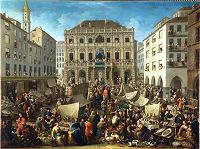 click to enlarge |
The Lottery Drawing in Piazza Delle Erbe, Turin
by Giovanni Michele Granieri Oil on Canvas - 1756 SN 195 By Karen Ellsworth. Docent. |
I.
On first glance this painting appears to be a market day. In the foreground we can see
melons being sold and as we move across to the right a woman selling flowers and slightly
off center an unfortunate accident where a horse and cart have fallen breaking all the
wares of the distraught vendor. Only a few people seem to be interested in this happening.
Moving around we see hats, baskets and sausages displayed and various buyers and sellers
discussing the goods.
The colors are subdued. The light is not dramatic and seems to be coming from the upper
left highlighting the building on the right although it is not consistent. The colors are
somewhat clearer in the foreground and fade in the far background to the left but not the
right. The middle ground seems to have figures slightly smaller as you move back toward
the balcony scene. It is difficult to tell what is happening on the balcony. The vendors
swagged stalls and the buildings lead your eye to the City Hall building.
The painting has a central building and two side buildings. People are looking out their
windows and balconies toward the draped central balcony of the building in the middle. The
two groups of people, vendors and their customers and those focusing on the balcony don't
seem to be aware of each other.
II.
This painting was originally called a CROWDED MARKETPLACE. It is actually about a lottery
where the building in the center is the City Hall and on the balcony an orphan pulls out
of a box the winning ticket. You can see some of the people hold lottery tickets. Also
curiously some of the women in the crowd appear to be holding spindles. The men in the
melon area seem preoccupied with smelling the melons. It is a genre scene with more than
meets the eye. It would be quite interesting to have a conversation with the artist to
discover the full meaning of his painting.
Very little is known about the artist Giovanni Michele Granieri other than he was active
in Turin, Italy in the l700's and that his master was Olivero. The buildings on either
side in the piazza were torn down shortly after this was painted and replaced by others.
Also the tower was pulled down in 1779. It is thought that paintings of this size and
subject were Granieri's stock and trade.
This painting is quite interesting to me and I would like to find out more
about it. There is an article in Italian in the file in the library and also a letter from
the Museo Civico Di Torino dated 1950 that leads me to believe we could get further
information on Granieri ( sometimes spelled Graneri)
and Olivera his master.
I could not find any information in the Dictionary of Art. Linda had what I have used in
her library file. I also have limited information from Suida and Tomeroy. Linda looked
through Mitchell Merling's file and found nothing further. The painting seems to either be
crooked in the frame or off balance in some way when you stand back and look at it. I also
would like to find out why Dr. Merling put it in this particular gallery.
I would like to get on a ladder with a magnifying glass and study the balcony of the city
hall building. The perspective also seem to be not quite right ( on purpose?) Perhaps -
because the whole scene taking place seems to be not quite right.
I probably would not focus on this painting in this gallery but might mention it as a
genre scene and compare it to our markets here and abroad such as we have in Sarasota on
Lemon Ave and Bradenton on Main Street.
The Lottery might be a good painting to develop for children's tours because they could
relate history and social customs from this period and compare lotteries and marketing to
today. Art terms to explore could be symmetry / asymmetry, foreground /background,
value/color, perspective,
line/shape and the subject matter.
***Additional Information: Dr. Merling told me the painting is about chance. The person
drawing the winning lottery ticket is an orphan on the balcony, standing next to her is a
priest. The lotteries (called Lotto) were often a way to support public institutions such
as orphanages and asylums. This information was in an Italian encyclopedia in Italian.
Chance is also indicated by the horse and cart that stumbled and spilled the owner's wares
before he could sell them at market. The museum is currently in a discussion with others
who are researching the same subject and our particular painting. I will update this paper
as soon as I have additional information.
The marketplace as well as the lotto were popular throughout Europe during the mid 1700's.
Subjects showing peasants going about their daily life ( genre scenes ) were also painted
by Pieter Brueghel, The Elder.